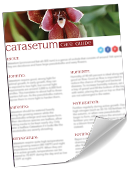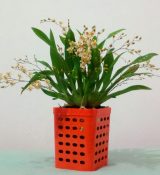Orchid Plant Pollination By Man – Part One
Author: adminNo Comments
Blooming, Care and Culture, Classification, Growing Indoors, Growing Outdoors, Propagation
The procedure by which man pollinates an orchid is mechanically identical to that by which an insect pollinates it, except that man has advantages.
For instance, he can operate at any time of day or night, he has the pod parent and the pollen parent together on a bench; the operation is not haphazard and is the result of quite a different quest from threat of an insect searching for nectar with no intention of fertilizing a beautiful orchid.
The implement most often used by a hybridizer when pollinating is a tooth pick or a matchstick with a point sharpened into a chisel shape. Some genera are easier to pollinate than others; among the easier ones are the cattleyas and the cymbidiums, and among the more difficult are the paphiopedilums.
As an example, the cattleya is taken first. The two potential parent plants are arranged together on a bench in the greenhouse, as no laboratory precautions as regards sterility are necessary at this stage. A sheet of clean paper is placed under them in case the pollinia are dropped, so that they can be found easily. A note book is needed to enter the names of the parents, the date, etc. Two matchsticks with chisel points are used, and the pollinia are removed from the first plant with a matchstick, and placed on the paper still attached to the matchstick. The pollinia are beneathe the anther cap which is hinged and easily removed and usually the pollinia come away with the anther cap. The pollinia are in two pairs (in Laelia, four pairs) are yellow and disc-like. The pollinia of the second flower are then detached in the same way. One pollen mass or disc is then placed, still at the end of its matchstick, on to the stigmatic surface of a flower. The other ‘pollinated’ matchstick is used in the same way with the other flower. The stigmatic surface is a depression just behind the site of the pollen cap. The result is that each flower has been fertilized by the other one and six pollen discs are left over to be used in pollinating other flowers if desirable.
Check out Orchid Plant Pollination By Man – Part Two, for more information and examples on pollinating orchid plants by man!


Ask an Expert
Questions about orchids?
Our experts love a challenge!
Photo of the Week
Submit your photo to be featured on the blog!
More Photo of the Week Winners
Submit Photo







